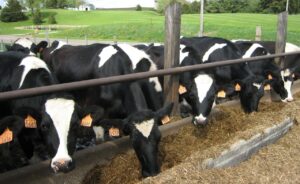Five ways to feed dairy cows more sustainably
5th December 2022
Feeding for optimum rumen function is a way farmers can help to maximise productivity from their herd and potentially improve sustainability, listeners on the latest Mole Valley Farmers’ Podcast heard.

If milk quality is important for your contract, then understanding nutrient sources is a must.
Increasingly, milk processors are demanding farmers produce milk more sustainably, meaning they are being forced to look for solutions on their farms.
Mole Valley Farmers’ nutritionist, Becky Hewlett, said farmers should try not to view sustainability negatively as it doesn’t have to cost more and can lead to increased profitability.
“There is not a one size fits all approach to feeding sustainably,” she said. “If you are utilising homegrown forages, you can lower your carbon footprint. But likewise, if you feed more intensively, you can drop the CO2 produced per litre of milk. It’s important you get the most out of your milk contract, and that can then be invested back in the business.”
Ms Hewlett and Mole Valley Farmers’ nutritionist Dr Kerensa Hawkey outlined some ways farmers could feed more sustainably on their farms. They included:
1. Reviewing forage quality and type
Taking regular samples to review silage quality and intake potential is vital. Look at the type of forage being fed. A leafier, higher digestible grass can reduce emissions, as can combining maize and grass silage, explained Ms Hewlett. Other options include use of herbal leys and clover for nitrogen fixation.
2. Making the most from your milk contract
If milk quality is important for your contract, then understanding nutrient sources is a must. If there are multiple starch sources, there will be different fermentation rates and energy supply, which can result in more milk protein.
If milk fat is the aim, it’s important to balance the acetate-to-propionate ratio in the rumen and ensure adequate digestible and physically effective fibre. TMR presentation must also be considered.
Ultimately a more efficient rumen can lead to greater sustainability and profitability.
3. Protein sources
Feeding excess protein is costly for both the farmer and the environment. Therefore, it’s important to get the correct balance of rumen degradable protein and rumen bypass protein.
Dr Hawkey said: “Soya can be looked at quite negatively, but it provides a good source of amino acids as well as being a good source of energy. If you are using it in the ration, don’t use more than is necessary.”
Dr Hawkey discussed several soya alternatives, including rapemeal, which would have to be fed in higher quantities than soya due to lower energy and protein. Another option is NovoPro, a rumen-protected rapeseed product that can be supplied as a compound, blend, meal or straight.
NovoPro has been found to increase dry matter intake leading to an extra 1.7 litres of milk. It has an excellent protein digestibility, lower carbon footprint compared to soya and flexibility when feeding.
Dr Hawkey also highlighted the use of rumen protected amino acids, such as methionine, which is often limiting for milk production. Rumen protected amino acids take up less space in the ration compared to traditional protein sources and have benefits for liver function and the immune system.
Ms Hewlett said farmers could also consider reducing the crude protein level from the traditional 18% to 16-17% by feeding these rumen protected amino acids.
Growing other protein sources, such as beans, should also be considered.
4. Including co-products
Co-products, such as distillers and biscuit meal, can increase nutrient intake and reduce emissions, as they are a by-product of food manufacturing.
5. Consider an additive, feeding a live yeast
Live yeasts could be helpful for farmers with poor silage quality to reduce lactate production and the risk of acidosis and improve fibre digestion. “A stable rumen can lead to more yield from forage,” said Dr Hawkey.
Ms Hewlett added: “Farmers need to break down sustainability into every aspect of their farm. This requires the farm to be looked at in detail. Farmers must then assess the best options for sustainability, productivity and profitability.”
Dr Hawkey added: “If you feed efficiently, you can drive the rumen in the direction you want for optimum output.”
To listen to this podcast or other Mole Valley Farmers’ podcasts, visit www.moleonline.com/podcasts
